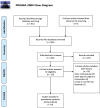Transversus Abdominis Plane Block Appears to Be Effective and Safe as a Part of Multimodal Analgesia in Bariatric Surgery: a Meta-analysis and Systematic Review of Randomized Controlled Trials
- PMID: 33083978
- PMCID: PMC7847866
- DOI: 10.1007/s11695-020-04973-8
Transversus Abdominis Plane Block Appears to Be Effective and Safe as a Part of Multimodal Analgesia in Bariatric Surgery: a Meta-analysis and Systematic Review of Randomized Controlled Trials
Abstract
Purpose: Pain after bariatric surgery can prolong recovery. This patient group is highly susceptible to opioid-related side effects. Enhanced Recovery After Surgery guidelines strongly recommend the administration of multimodal medications to reduce narcotic consumption. However, the role of ultrasound-guided transversus abdominis plane (USG-TAP) block in multimodal analgesia of weight loss surgeries remains controversial.
Materials and methods: A systematic search was performed in four databases for studies published up to September 2019. We considered randomized controlled trials that assessed the efficacy of perioperative USG-TAP block as a part of multimodal analgesia in patients with laparoscopic bariatric surgery.
Results: Eight studies (525 patients) were included in the meta-analysis. Pooled analysis showed lower pain scores with USG-TAP block at every evaluated time point and lower opioid requirement in the USG-TAP block group (weighted mean difference (WMD) = - 7.59 mg; 95% CI - 9.86, - 5.39; p < 0.001). Time to ambulate was shorter with USG-TAP block (WMD = - 2.22 h; 95% CI - 3.89, - 0.56; p = 0.009). This intervention also seemed to be safe: only three non-severe complications with USG-TAP block were reported in the included studies.
Conclusion: Our results may support the incorporation of USG-TAP block into multimodal analgesia regimens of ERAS protocols for bariatric surgery.
Keywords: Bariatric surgery; Meta-analysis; Pain; TAP block.
Conflict of interest statement
The authors declare that they have no conflict of interest.
Figures



Similar articles
-
Benefits of Transversus Abdominis Plane Block on Postoperative Analgesia after Bariatric Surgery: A Systematic Review and Meta-Analysis.Pain Physician. 2021 Aug;24(5):345-358. Pain Physician. 2021. PMID: 34323436
-
Ultrasound-Guided Transversus Abdominis Plane Block as an Effective Path to Reduce Opioid Consumption After Laparoscopic Bariatric Surgery: A Systematic Review and Meta-analysis of Randomized Controlled Trials.Obes Surg. 2024 Nov;34(11):4244-4254. doi: 10.1007/s11695-024-07532-7. Epub 2024 Oct 10. Obes Surg. 2024. PMID: 39384705
-
Efficacy of ultrasound-guided transversus abdominis plane block after laparoscopic bariatric surgery: a double blind, randomized, controlled study.Obes Surg. 2013 Apr;23(4):548-53. doi: 10.1007/s11695-012-0819-5. Obes Surg. 2013. PMID: 23361468 Clinical Trial.
-
Efficacy of ultrasound-guided transversus abdominis plane (TAP) block for postoperative analgesia in laparoscopic gastric sleeve resection: a randomized single blinded case control study.Surg Endosc. 2018 Dec;32(12):4985-4989. doi: 10.1007/s00464-018-6261-6. Epub 2018 Jun 4. Surg Endosc. 2018. PMID: 29869078 Clinical Trial.
-
Transversus Abdominis Plane Block in Laparoscopic Bariatric Surgery-a Systematic Review and Meta-Analysis of Randomized Controlled Trials.Obes Surg. 2021 Jan;31(1):133-142. doi: 10.1007/s11695-020-04898-2. Epub 2020 Aug 10. Obes Surg. 2021. PMID: 32779074
Cited by
-
The analgesic effect and inflammatory mechanism of nonsteroidal analgesics combined with nerve block in post-gynecologic surgery patients.Am J Transl Res. 2021 Oct 15;13(10):11608-11616. eCollection 2021. Am J Transl Res. 2021. PMID: 34786086 Free PMC article.
-
Effect of Intraoperative Lung Recruitment and Transversus Abdominis Plane Block in Laparoscopic Bariatric Surgery on Postoperative Lung Functions: A Randomized Controlled Study.Anesth Pain Med. 2023 Mar 5;13(2):e128440. doi: 10.5812/aapm-128440. eCollection 2023 Apr. Anesth Pain Med. 2023. PMID: 37645008 Free PMC article.
-
Learning curve of ultrasound-guided surgeon-administered transversus abdominis plane (UGSA-TAP) block on a porcine model.Heliyon. 2024 Jan 23;10(3):e25006. doi: 10.1016/j.heliyon.2024.e25006. eCollection 2024 Feb 15. Heliyon. 2024. PMID: 38322832 Free PMC article.
-
Bilateral Ultrasound-Guided External Oblique Intercostal Block Vs. Modified Thoracoabdominal Nerve Block Through Perichondrial Approach for Postoperative Analgesia in Patients Undergoing Laparoscopic Sleeve Gastrectomy Surgery: A Randomized Controlled Study.Obes Surg. 2024 Oct;34(10):3726-3734. doi: 10.1007/s11695-024-07454-4. Epub 2024 Sep 11. Obes Surg. 2024. PMID: 39259439 Clinical Trial.
-
Analgesic Efficacy and Outcomes of Ultrasound-guided Erector Spinae Plane Block in Patients Undergoing Bariatric and Metabolic Surgeries: A Systematic Review.J Med Ultrasound. 2023 Feb 13;31(3):178-187. doi: 10.4103/jmu.jmu_112_22. eCollection 2023 Jul-Sep. J Med Ultrasound. 2023. PMID: 38025009 Free PMC article. Review.
References
-
- Gamboa JSB. Pain management in weight loss surgery: aiming for multimodal approach. Adv Obes Weight Manag Control. 2016;5(2):00125.
-
- Fletcher D, Fermanian C, Mardaye A, Aegerter P, Pain, Regional Anesthesia Committee of the French A et al. A patient-based national survey on postoperative pain management in France reveals significant achievements and persistent challenges. Pain. 2008;137(2):441–451. - PubMed
-
- Meissner W, Huygen F, Neugebauer EAM, Osterbrink J, Benhamou D, Betteridge N, Coluzzi F, de Andres J, Fawcett W, Fletcher D, Kalso E, Kehlet H, Morlion B, Montes Pérez A, Pergolizzi J, Schäfer M. Management of acute pain in the postoperative setting: the importance of quality indicators. Curr Med Res Opin. 2018;34(1):187–196. - PubMed
-
- Sommer M, de Rijke JM, van Kleef M, Kessels AG, Peters ML, Geurts JW, et al. The prevalence of postoperative pain in a sample of 1490 surgical inpatients. Eur J Anaesthesiol. 2008;25(4):267–274. - PubMed
Publication types
MeSH terms
Substances
LinkOut - more resources
Full Text Sources
Medical
Miscellaneous

